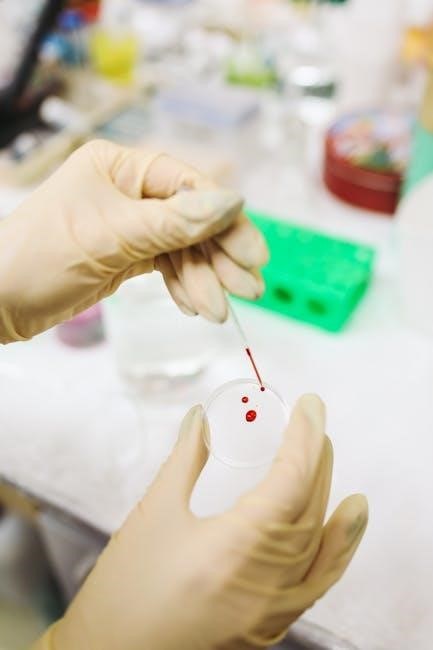

Overview of AP Biology Unit 2
AP Biology Unit 2 focuses on cellular structure, transport, and division. Multiple-choice questions test understanding of cell theory, organelles, and transport mechanisms. Practice tests and scoring guides aid exam preparation effectively.
1.1 Key Topics Covered in Unit 2
AP Biology Unit 2 covers fundamental concepts of cellular biology, including cell theory, cellular structure, and transport mechanisms. Key topics include the cell theory’s core principles, such as all living organisms being composed of cells and cells being the basic units of life. Students explore the structure and function of major organelles like mitochondria, the endoplasmic reticulum, and ribosomes. The unit also delves into cellular transport mechanisms, including passive transport (diffusion, osmosis) and active transport. Additionally, cell division processes like binary fission in prokaryotes and the role of the nucleolus in protein synthesis are emphasized; These topics are essential for understanding cellular function and prepare students for multiple-choice questions on the AP Biology exam.
1.2 Importance of Multiple-Choice Questions in AP Biology
Multiple-choice questions (MCQs) are a cornerstone of AP Biology assessments, including Unit 2. They evaluate students’ ability to apply knowledge of cellular biology, from organelle functions to transport mechanisms. MCQs test critical thinking and the capacity to eliminate incorrect answers, enhancing problem-solving skills. Regular practice with MCQs helps students identify knowledge gaps and master complex concepts. Scoring guides provide clear expectations, ensuring transparency and consistency in grading. Additionally, MCQs simulate the actual exam environment, building time management and test-taking strategies. By focusing on high-yield topics like cell theory and cellular transport, MCQs effectively prepare students for the challenges of the AP Biology exam, ensuring they are well-equipped to succeed.
Cell Theory and Cellular Structure
Cell theory forms the foundation of cellular biology, emphasizing cells as life’s basic units. Understanding organelles and their functions, like mitochondria and ribosomes, is crucial for mastering AP Biology Unit 2 concepts.
2.1 Key Components of the Cell Theory
The cell theory, a cornerstone of biology, comprises three main principles. First, all living organisms are composed of one or more cells, emphasizing cells as the fundamental units of life. Second, cells are the basic structural and functional units of organisms, carrying out essential life processes. Third, new cells arise from pre-existing cells, explaining cellular reproduction. These principles, developed by Schleiden, Schwann, and Virchow, form the foundation for understanding cellular biology. Multiple-choice questions often test the ability to distinguish these tenets from other biological concepts. For example, questions may ask which statement is not part of the cell theory, such as “cells can arise spontaneously,” highlighting the importance of precise understanding. Mastery of these components is critical for success in AP Biology Unit 2, as they underpin topics like cellular structure, transport, and division.
2.2 Structure and Function of Major Organelles
Major organelles play critical roles in cellular function. The nucleus houses genetic material, regulating cell activities, while mitochondria generate energy through ATP production. The endoplasmic reticulum synthesizes proteins and lipids, with the rough ER having ribosomes for protein synthesis. The smooth ER processes lipids and detoxifies. The Golgi apparatus modifies, sorts, and transports proteins and lipids. Lysosomes contain digestive enzymes, breaking down cellular waste. Ribosomes, found throughout the cytoplasm, synthesize proteins. Multiple-choice questions often test the ability to match organelles with their functions. For example, “Which organelle is responsible for protein synthesis?” or “What is the primary function of the mitochondria?” Understanding these structures is essential for analyzing cellular processes and transport mechanisms in AP Biology Unit 2.

Cell Division and Transport Mechanisms
Cell division in prokaryotes occurs via binary fission, while transport mechanisms include passive transport (diffusion, osmosis) and active transport (energy-dependent). These processes are fundamental to cellular survival and function.
3.1 Binary Fission in Prokaryotes
Binary fission is the method by which prokaryotes reproduce. It involves the duplication of DNA, with each copy attaching to the cell membrane. The cell then elongates and splits into two identical daughter cells. This process is simple and rapid, allowing prokaryotes to quickly colonize new environments. Since prokaryotes lack a nucleus and other membrane-bound organelles, their cell division is less complex compared to eukaryotic mitosis. Binary fission ensures genetic continuity and is a key factor in the survival and adaptability of prokaryotic organisms. Understanding this process is crucial for AP Biology Unit 2, as it highlights fundamental differences between prokaryotic and eukaryotic cells.
3.2 Passive and Active Transport Across Cell Membranes
Passive transport involves the movement of substances across cell membranes without the use of energy, relying on concentration gradients. Diffusion, including simple diffusion and facilitated diffusion, allows particles to move from high to low concentration. Osmosis, a type of diffusion, specifically refers to water movement. Active transport, however, requires energy (ATP) and carrier proteins to move substances against their concentration gradient. This process is crucial for maintaining cellular homeostasis and enabling cells to accumulate essential nutrients. Key examples include the absorption of glucose and amino acids. Understanding these transport mechanisms is vital for AP Biology Unit 2, as they underpin cellular function and metabolism. Multiple-choice questions often test knowledge of transport types, energy requirements, and the role of membrane proteins.

Practice Questions and Their Relevance
Practice questions are essential for mastering AP Biology Unit 2, as they reinforce concepts like cellular structure, transport, and division. They help identify knowledge gaps and improve test-taking strategies.
4.1 Common Question Types in Unit 2 Multiple-Choice Tests
In Unit 2, multiple-choice questions often focus on identifying organelle functions, understanding passive vs. active transport, and explaining cell division processes. Some questions present scenarios requiring application of cell theory principles. Others may ask to differentiate between structures or mechanisms. The questions may include images or diagrams, such as labeling parts of a cell or illustrating transport across membranes. Additionally, some items present laboratory-based scenarios, testing the ability to interpret data or predict outcomes. These question types assess both factual recall and critical thinking, mirroring the exam’s emphasis on applying knowledge to real biological situations.
4.2 Scoring Guides and Answer Keys
Scoring guides and answer keys are essential tools for evaluating performance on Unit 2 multiple-choice tests. These resources provide detailed breakdowns of correct answers, ensuring clarity and consistency in grading. For multiple-choice questions, answer keys list the correct options, while scoring guides outline point allocations for free-response questions. Many practice tests include these documents to help students assess their understanding and identify areas for improvement. By reviewing answer keys, students can verify their responses and learn from mistakes. Scoring guides also offer insights into how examiners evaluate answers, helping students align their responses with grading criteria; These materials are widely available online, often accompanying practice tests and quizzes, and are invaluable for targeted exam preparation and self-assessment.

Test-Taking Strategies for Success
Utilize practice tests to refine your approach. Eliminate incorrect options, manage time wisely, and stay focused. Review answers if possible to ensure accuracy and maximize scores effectively.
5.1 Effective Time Management During the Exam
Effective time management is crucial for success in the AP Biology Unit 2 exam. Allocate 1-2 minutes per multiple-choice question to ensure thorough analysis. Start with easier questions to secure early points, then return to challenging ones. Budget additional time for free-response questions, which require detailed explanations. By prioritizing questions based on confidence and complexity, you can maximize your score. Practice with timed mock exams to build stamina and improve pacing. Remember, adherence to time limits prevents last-minute rushes and enhances overall performance. Properly balancing speed and accuracy ensures that you address all questions effectively within the allotted timeframe.
5;2 Tips for Analyzing and Eliminating Incorrect Options
To excel in AP Biology Unit 2 multiple-choice questions, develop strategies to analyze and eliminate incorrect options. Start by carefully reading the question stem and identifying key terms. Look for answer choices that contradict basic biological principles or contain extreme language, such as “always” or “never,” which are often incorrect. Use the process of elimination to remove implausible options first, increasing the likelihood of selecting the correct answer. Pay attention to recurring themes in practice questions, as they often reflect common exam topics. Additionally, avoid second-guessing yourself after making a selection. If time permits, cross-reference with diagrams or notes to confirm your choice. Finally, practice with past papers to familiarize yourself with the format and improve your ability to identify distractors effectively.